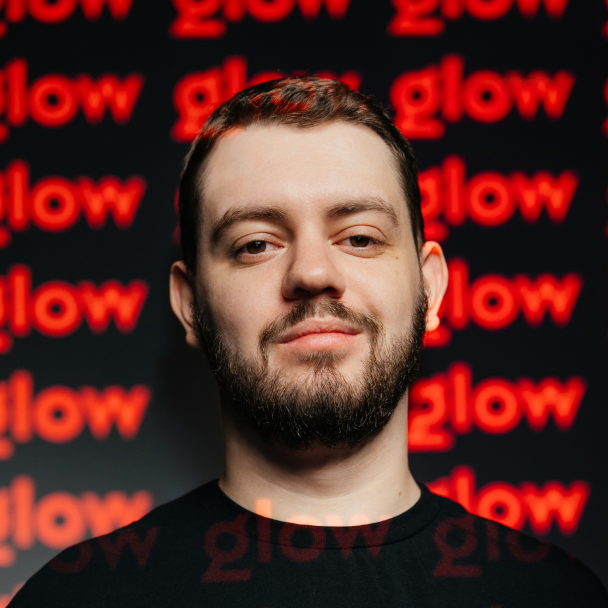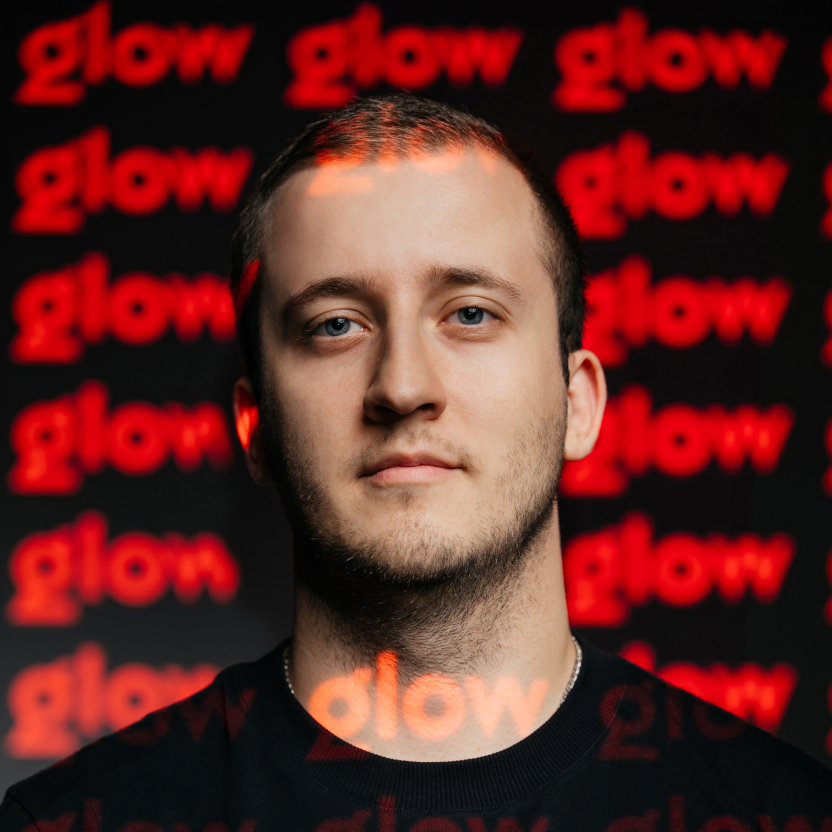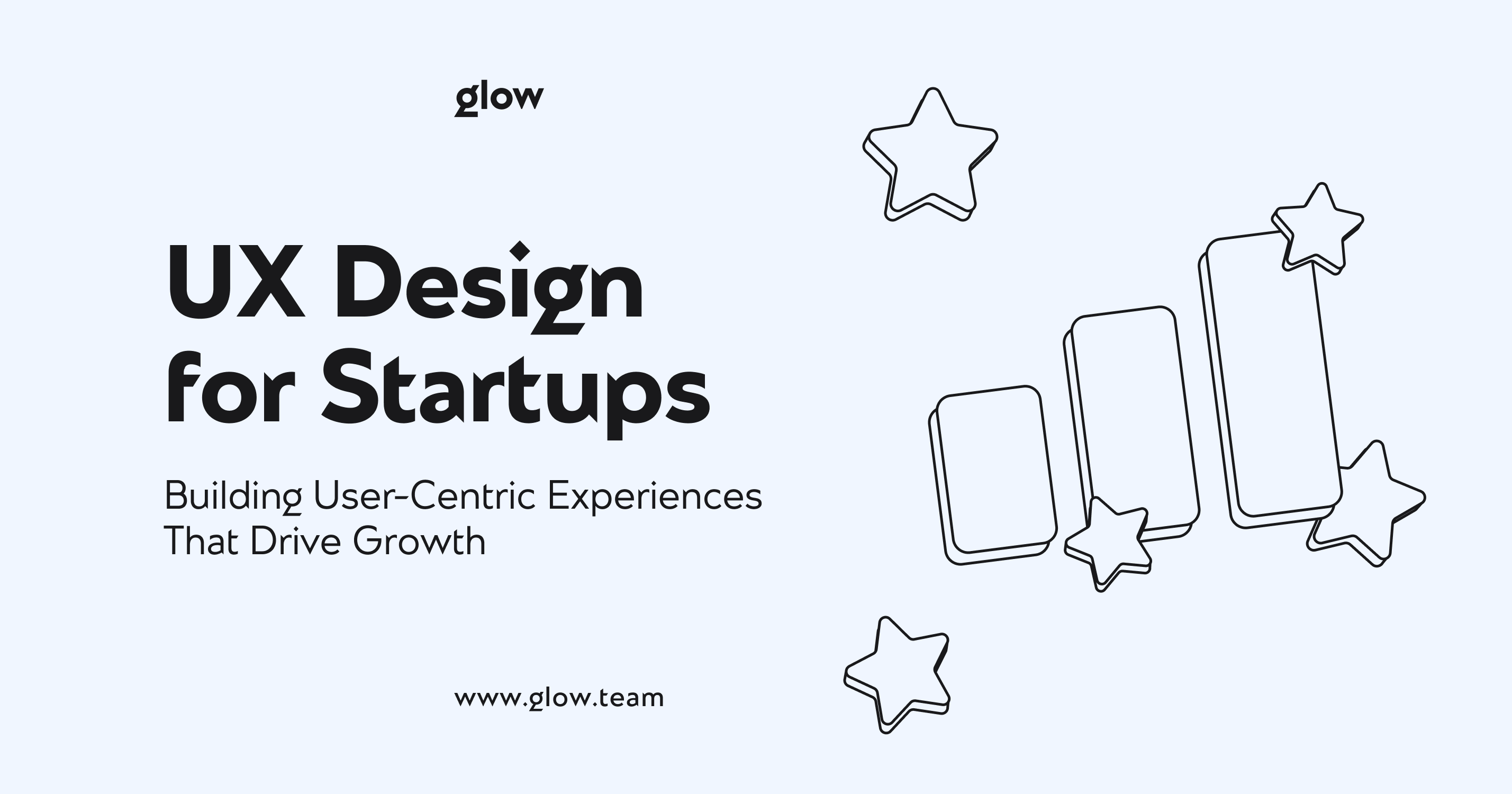Understanding Design Research in Web and Product Development
Design research is a systematic process of gathering information about users' needs, behaviors, and the context in which they use a product. It's not just an extra step in creating websites or apps. It's a fundamental approach that helps create truly effective solutions.
At Glow, we firmly believe that great digital product design starts with a deep understanding of users. When we talk about design research, we mean the purposeful study of people, their needs, desires, motivations, and limitations. It's a process that allows us to go beyond assumptions and turn to real data.
In our practice at Glow, we see how well-conducted research transforms projects from simply beautiful to truly useful for users. Research helps us create attractive, functional, intuitive interfaces that work to achieve business goals.

Why Design Research Matters for Web Designers
To Understand User Behavior and Context
When you start a new project, the first thing to do is immerse yourself in the world of users. Product design research helps us understand:
- How people interact with existing solutions
- What their goals, needs, and pain points are
- In what context do they use the product (at home, on the road, at work)
- What emotions does interacting with the product evoke
- What technical limitations may affect the use of the product
For example, while working on a website for an online booking service, we found that users often interrupted the process because they had to register. It led to the creation of a quick booking option without mandatory registration, significantly increasing conversion rates.
Understanding the context of use is also critical. It's one thing to design a website that will be used at home on a large screen, and quite another to create an app that will be used on the go or in stressful situations. Product design research helps us understand these nuances and adapt solutions to real-world conditions.
To Uncover Actionable Insights
Systematic design research often leads to discoveries that other means cannot obtain. By observing how users interact with a product in real-world conditions, you can notice nuances. These nuances can inspire innovative solutions. For example, in one CRM system interface redesign project, observing managers at work revealed that they spent much time switching between screens. This led to creating a single control panel where all the necessary data was collected in one place.
Often, the most valuable ideas come from unexpected sources. During your research, pay attention not only to what users say, but also to what they do. These observations can lead to insights that users would be unable to articulate.
Design research methods also help identify hidden user needs — those that users may not be aware of or consider important. These non-obvious findings often become a source of competitive advantage and innovation.
To Eliminate Assumptions and Bias
We all have assumptions about how users should interact with a product. However, these assumptions are often incorrect. The design research method allows us to test hypotheses and make decisions based on real data rather than subjective opinions. At Glow, we avoid phrases like "I think users want..." and instead say "Our research shows that users need...".
Cognitive biases can seriously affect the product development process. For example, the false consensus effect makes us think other people think and act like we do. And the confirmation bias makes us only pay attention to information that confirms our beliefs. Design research helps us overcome these biases and see the real picture.
Another common problem is designing for ourselves or the client, rather than for the actual users. Clients often request features that seem important but irrelevant to end users. Objective research data helps us discuss priorities with clients in a reasoned manner and focus on what is truly valuable to the target audience.
To Improve ROI and Reduce Redesign Costs
Investing in product design research early in the project can significantly reduce costs in the long run. Identifying and fixing problems before development begins is much cheaper than reworking a finished product. In our experience, every dollar invested in research saves up to ten dollars in development and support.
Many companies learn this the hard way. We have seen projects where a lack of research led to the creation of features that no one used or interfaces that frustrated users. As a result, significant resources had to be spent on reworking the product.
Design research also helps prioritize and focus efforts on the aspects of the product that matter to users. This is especially valuable when resources are limited and you must make the most of your time and budget. Instead of spending resources on developing every possible feature, we focus on those delivering the most value.

When Should You Conduct Design Research?
At the Start of a New Web or Product Design Project
Initial research helps determine the overall direction of the project. At the initial stage, it is essential to interview stakeholders, analyze competitors, and create user profiles. This information serves as the basis for all subsequent design decisions.
Investing in research at the beginning lays a solid foundation for the entire project. It helps form a clear product vision, identify key success metrics, and set realistic expectations for everyone involved. Without this foundation, the project risks going off course, exceeding the budget, or failing to achieve its goals.
Initial design research also helps identify potential risks and issues before they become serious obstacles. For example, competitor research may reveal that the market is already saturated with similar solutions and that a more differentiated approach is needed to succeed. Or user research may uncover technical limitations that need to be considered during development.
When Adding or Improving Features
Design research methods are also valuable when adding new features to an existing product. It helps you understand how well the new functionality meets user needs and how it will fit into the overall user experience.
Before adding a new feature, ensuring that it solves a real problem for users and does not unnecessarily complicate the interface is vital. Product design research helps evaluate the potential value of a feature and determine the best way to implement it.
We also use research to evaluate the effectiveness of existing features. By analyzing how users interact with the product, we can identify features that are rarely used or cause difficulties and decide whether to improve or remove them.
During Redesigns and Optimization
When redesigning an existing product, it is essential to understand what works well and what needs improvement. Product design research helps identify problem areas and find ways to solve them. For example, analyzing user flows and heat maps can reveal that important information is overlooked due to its location on the page.
Redesigning without prior research is a risky endeavor. You may accidentally remove or change features that were important to users, or introduce changes that disrupt familiar usage patterns. Design research helps make the redesign process more focused and less risky.
Conversion optimization should also be based on research data. Instead of randomly experimenting with different design elements, we use research to identify barriers preventing users from achieving their goals and focus our optimization efforts on those areas.
When Targeting New Audiences
When a product is expanded to reach a new audience, it is essential to understand their characteristics and needs. Design research helps adapt the product for new users while maintaining its value for the existing audience.
Different user groups may have different expectations, preferences, and levels of technical literacy. Research helps identify these differences and find a balance between meeting the needs of various audiences and maintaining product integrity.
Entering new markets, especially international ones, requires understanding cultural characteristics, local regulatory requirements, and the competitive environment. Product design research in this context includes more than just studying users. It also involves a broader analysis of the market situation and local conditions.
Across the Product Lifecycle
Research should not end after a product is launched. Continuous design research allows you to track changes in user behavior, identify new needs, and evaluate the effectiveness of changes made.
Markets, technologies, and user expectations are constantly changing. What worked yesterday may become ineffective tomorrow. Regular research helps you stay on top of these changes and adapt your product promptly.
Glow takes an iterative approach with a continuous cycle of research, design, development, and evaluation. Each iteration builds on the data gathered during previous cycles, allowing us to improve the product and adapt it to changing conditions gradually.

Design Research Methods for Digital Products
User Interviews
One of the most valuable design research methods is direct conversations with users. These can be structured or semi-structured. They usually include questions about goals, problems, and experiences with similar products.
The art of conducting a good interview is to ask the right questions and listen carefully. Interviews with extreme users—those who have had positive or negative experiences with the product—are particularly valuable. Their stories often contain important nuances that may be overlooked when studying only "average" users.
Usability Testing
Observing how real users interact with a product helps identify usability issues. There are several types of usability testing:
- Moderated testing: the researcher observes the user in real time and asks clarifying questions
- Unmoderated testing: data is collected automatically using special tools
- Laboratory testing: conducted in a controlled environment using special equipment
- Remote testing: conducted via the Internet, allowing users from different regions to be tested
- A/B testing: comparing two versions of an interface to determine which one works better
Usability testing can be conducted at various stages of development, from prototypes to fully functional products. The earlier testing begins, the easier and cheaper it will be to fix any issues that arise.
Card Sorting
This technique helps you understand how users organize information. Participants are asked to group cards with different themes or functions into categories that make sense to them. The results help create an intuitive information architecture.
Card sorting is particularly useful when developing complex products with many content and features, such as information portals, e-commerce, or corporate systems. It helps ensure that the structure of the website or application meets user expectations.
There are two main types of card sorting: open and closed. In open sorting, participants create the categories themselves, while in closed sorting, the categories are defined in advance. The choice of method depends on the research goals and the degree of freedom we want to give participants.
Surveys and Questionnaires
To collect quantitative data from many users, we use online surveys. They allow us to quickly obtain statistically significant data about the preferences and habits of the target audience. Product design research combines qualitative and quantitative methods to get the full picture.
A well-designed survey should be concise, focused, and easy to complete. We avoid ambiguous or leading questions and use simple and clear language. Surveys should also be adapted for different devices so users can complete them on a smartphone or tablet.
Observational Studies
Sometimes, the most valuable thing is to observe users in their natural environment. This approach lets you notice subtle behavior patterns that users may not mention in interviews or surveys.
Observational studies can include direct observation, where the researcher is present with the user, and indirect observation, such as video recordings or special tools for tracking user actions on a website or in an app.
An essential aspect of observational research is minimizing the observer's influence on the participants' behavior. People may change their behavior when they know they are being observed (the Hawthorne effect). We create conditions in which participants feel as natural as possible and consider the possible influence of observation when analyzing the results.
Contextual Inquiry
This design research method involves observing users in the real context of product use. For example, if we are developing an app for healthcare professionals, we might spend time observing their work processes in a clinic.
Contextual studies are particularly valuable because they allow us to see how a product fits into the broader context of a user's life or work. This can reveal factors that go unnoticed in a lab setting, such as interruptions, multitasking, or interactions with other people and systems.
Diary Studies & Longitudinal Research
Diary-based research allows you to collect data on the actual use of a product over time, including the context of use, difficulties encountered, and changes in user behavior as they become more familiar with the product.
Longitudinal studies, which track the same users over an extended period, can reveal how their perceptions and use of the product change over time. This is particularly valuable for understanding the adaptation process to new products or features.

Balancing Qualitative and Quantitative Data
How to Combine Both Approaches Effectively
At Glow, the best understanding of users is achieved by combining qualitative and quantitative research methods. Qualitative methods help us understand "why" users behave in a certain way, while quantitative methods show "what" and "how many" users do certain things.
Here are some examples of how we combine different types of data:
-
Website analytics may show that many users leave the checkout page (quantitative data). Through interviews or usability testing, we learn why this is happening (qualitative data) — perhaps the form is too long, or users don't understand what information to enter.
-
A survey may reveal a certain feature with low satisfaction ratings (quantitative data). Observation sessions help us understand users' specific problems when using this feature (qualitative data).
-
Interviews may reveal a need for a new feature (qualitative data). A/B testing helps determine which implementation of this feature will be more effective (quantitative data).
Design research requires interpreting different data types and finding connections between them. We often start with broad quantitative research to identify general trends, and then conduct more in-depth qualitative research to understand the patterns we have identified.

Overcoming Design Research Challenges
Time and Budget Constraints
One of the most common problems is limited resources. It is not always possible to conduct a full-scale study. In such cases, Glow uses a "guerrilla research" approach — quick and inexpensive data collection methods. For example, testing a prototype with 5-7 users can reveal up to 80% of the main usability issues.
Here are a few ways to conduct effective research with limited resources:
- Prioritize questions: Focus on the most critical issues directly impacting the product's success.
- Use existing data: Analyze website analytics, user reviews, and support data.
- Combine methods: For example, include questions about a new feature in a regular satisfaction survey.
- Remote methods: Conducting testing and interviews online saves time and money on travel.
- Automation: Use tools to automatically collect and analyze data.
Stakeholder Buy-in and Resistance
Sometimes it can be challenging to convince clients or management of the need for product design research. In such cases, we share success stories and data on how research has helped other projects save time and money and improve the user experience. It is essential to speak the language of business and show how research helps achieve business goals.
Involving stakeholders in the research process can also help overcome resistance. When managers observe usability testing or hear user quotes, it often has a much greater impact than abstract reports or presentations.
Ethical Considerations
When conducting research, it is essential to always keep ethical considerations in mind. This includes:
- Informed consent: Participants must understand the purpose of the research and how their data will be used.
- Confidentiality: Participants' data must be protected.
- Right to refuse: Participants must be able to withdraw from the study at any time.
- Honest presentation of results: do not distort data, even if it does not meet expectations.
- Respect for participants: treat all participants with respect, regardless of their age, experience, or technical literacy.
- Special attention to vulnerable groups: adapt research methods to work with older people, children, or people with disabilities.
- Compensation: fairly compensate participants for their time and effort.
Design research methods must respect the rights and dignity of all research participants. At Glow, we always adhere to ethical principles and create a safe and comfortable environment for all research participants.

Future Trends in Design Research
AI-Powered Tools
AI is playing an increasingly important role in design research. Machine learning algorithms can analyze large amounts of data and identify patterns that are difficult for humans to notice.
Here are some ways AI can be used in design research:
- Automatic transcription and analysis of interviews
- Recognition of user emotions based on facial expressions or tone of voice
- Analysis of large sets of user feedback to identify common themes and issues
- Creation of personalized prototypes that adapt to user behavior
- Predicting user behavior based on historical data
AI does not replace human researchers, but it can significantly increase the efficiency and depth of research. It allows data to be processed and analyzed on a scale impractical for manual analysis.
Remote and Distributed Research
The pandemic has accelerated the shift to remote research, and this trend is continuing. At Glow, we actively use tools for remote usability testing, online interviews, and digital whiteboards for collaboration. This allows us to work with users from different countries without needing physical presence.
Remote research has its advantages:
- Reach a wider and more diverse audience
- Save time and money on travel
- Observe users in their natural environment
- More flexible session planning
- Ability to respond quickly to changes in research questions
However, they also have limitations:
- Less control over research conditions
- Difficulties in observing nonverbal cues
- Technical issues that may affect results
- Difficulties in establishing personal rapport
Sustainable and Inclusive Research
There is a growing focus on including different user groups in research, including people with disabilities and diverse cultural backgrounds. Design research must take into account user diversity and create products that are accessible to everyone.
Inclusive research requires adapting methods for different user groups. For example, when working with people with visual impairments, we modify materials to make them accessible using screen-reading software. When conducting research in different cultural contexts, we consider local customs and norms.

Case Example: How Design Research Drives Better UX
One of our clients at Glow, an educational company, approached us to redesign their online learning platform. Initially, they just wanted to "refresh" the design. However, our design research revealed that the problem ran deeper.
Our research included several stages:
-
Data analysis: We studied the website analytics and found a high bounce rate on pages with training materials.
-
User interviews: We conducted conversations to understand their experience using the platform.
-
Usability testing: We observed users performing typical tasks on the platform and recorded their problems.
-
Card sorting: We held sessions with users to understand how they organize training materials.
The results showed that people often got lost in the course structure and couldn't find the needed materials. The main problem wasn't the outdated design, but the confusing information architecture.
Based on this data, we developed a new platform structure with more intuitive navigation and a responsive design optimized for different devices and use cases.
The results were impressive:
- Time spent on the platform increased by 45%.
- The number of support requests regarding navigation decreased by 80%.
- Student performance improved by 23%.
- Instructor satisfaction with the platform increased from 6.2 to 8.7 on a 10-point scale.
The client was surprised by how effective the design research method proved, and now regularly invests in research when developing new features.
Conclusion: Research is Design
Design research is not just a separate stage of the process but an integral part of the design itself. As we often say at Glow, "research is not something we do before design; it is the first step in design."
Effective product design research helps create products that truly meet user needs. It reduces development time, lowers risks, and ultimately leads to successful products that people enjoy using.
Research not only identifies problems but also inspires innovative solutions. By observing how users interact with a product, we can spot opportunities for improvement that weren't obvious at first. Sometimes, the most creative ideas don't come from brainstorming in the office; they come from carefully observing real users.
Design research methods also help build empathy for users. When designers and developers see how real people interact with their product, they better understand their needs, limitations, and frustrations. This understanding influences all subsequent decisions and helps create more human and accessible interfaces.

Partner With Glow Team for Research-Driven Web Design
At Glow, every project should start with a deep understanding of users and business goals. Our team of experienced researchers uses proven design research methods to gather valuable data, which becomes the foundation for innovative design solutions.
Our research process is tailored to the specific needs of each project. We can offer a compact research package for startups with limited budgets that delivers maximum results at minimal cost. For larger organizations, we develop comprehensive research programs that can include a variety of methods and cover different user groups.
We don't just create beautiful interfaces — we develop products that solve real problems and bring measurable benefits to your business. Whether you're starting a new project or looking to improve an existing product, we're here to help you every step of the way.
Contact us to learn how design research can be the key to the success of your digital product!







